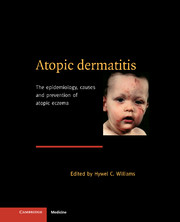Book contents
- Frontmatter
- Contents
- List of contributors
- Foreword Georg Rajka
- Preface
- Part I The nature of the problem
- Part II Descriptive studies which indicate the size of the problem
- Part III Analytical studies which point to causes of atopic dermatitis
- Part IV Intervention studies
- Part V Lessons from other fields of research
- Part VI Conclusions
- Additional information
- Index
- Plate section
Foreword Georg Rajka
Published online by Cambridge University Press: 17 August 2009
- Frontmatter
- Contents
- List of contributors
- Foreword Georg Rajka
- Preface
- Part I The nature of the problem
- Part II Descriptive studies which indicate the size of the problem
- Part III Analytical studies which point to causes of atopic dermatitis
- Part IV Intervention studies
- Part V Lessons from other fields of research
- Part VI Conclusions
- Additional information
- Index
- Plate section
Summary
Due to its clinical importance atopic dermatitis is the subject of several dermatological books reflecting our present knowledge. In the opinion of the Editor of this book, Professor Hywel C. Williams, it is necessary, however, to emphasize the epidemiological aspects which constitute the starting point of our understanding of this multi-aetiological and still problematic skin disease. Thus, a framework has been provided in this work within which the basic genetic and environmental factors, in addition to clinical features and natural history, are discussed by well known experts.
Immunological and allergic mechanisms are not the only cornerstone of this condition – another being the impaired, characteristically dry skin. In this volume immunoregulatory dysfunction and inhalent allergens, as well as dietary factors, are reviewed and the possible protective effect of early infections is suggested. Of other causative factors the maternal influences and environmental pollution are also emphasized.
A certain shift in our concept of the disease has occurred. We have to shed more light on the global aspects of atopic dermatitis including migrant populations and geographical epidemiology. We must also consider more thoroughly the socioeconomic perspectives, occupational relationships and disease prevention.
In order to attempt to clarify the problems, we have to redefine some earlier conclusions such as the clearing rate of atopic dermatitis, and consequently be aware that not only children but many adults are still affected by the disease.
The final chapter is devoted to the perspectives of future research.
- Type
- Chapter
- Information
- Atopic DermatitisThe Epidemiology, Causes and Prevention of Atopic Eczema, pp. xi - xiiPublisher: Cambridge University PressPrint publication year: 2000

